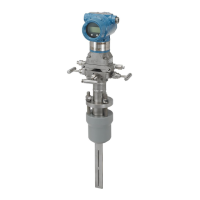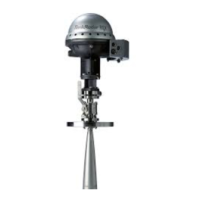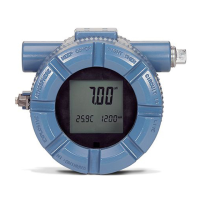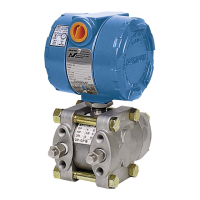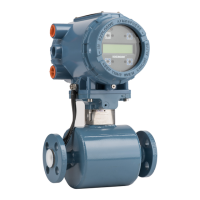Do you have a question about the Rosemount 3095FB and is the answer not in the manual?
Explains how to effectively use the manual for installation, configuration, and maintenance.
Introduces the scope of the installation section.
Details safety precautions required during installation.
Highlights critical safety warnings related to installation hazards.
Provides general guidelines for optimal transmitter performance and safety.
Discusses physical aspects and requirements for mounting the transmitter.
Outlines environmental factors affecting transmitter performance and installation.
Details the step-by-step process for installing the transmitter.
Reviews important points before proceeding with installation.
Instructions for physically mounting the transmitter.
Details on optional mounting brackets and their installation.
Guidelines for using mounting bolts to ensure a proper seal.
Specific requirements for mounting the transmitter based on flow type.
Guidance on connecting the transmitter to the process.
Information on the piping connecting the process to the transmitter.
Information on rotating the transmitter housing for accessibility.
Instructions for setting internal jumpers for configuration.
Information on compatibility with RTD assemblies.
Steps for installing the RTD cable assembly.
Steps for making electrical connections and powering the device.
Guidelines for properly grounding signal wiring.
Information on the required power supply for the transmitter.
Details on RS-485 bus configuration and requirements.
Information about explosion-proof housing and certifications.
Methods for effectively grounding the transmitter case.
Steps for installing the integral manifold.
Details on operating the integral manifold for zeroing and service.
Provides recommendations for effective Modbus communication.
Safety precautions for operating the transmitter.
Covers initial setup and installation of the UI software.
Guides users on navigating and using the software interface.
Details the different menu categories in the software.
Lists shortcuts for frequently used commands.
Outlines the steps for calibrating the transmitter.
Steps for configuring the transmitter on a bench.
Procedure for calibrating the transmitter in a bench setup.
Procedure for calibrating the transmitter in the field.
Explains the screens found within the UI software.
Defines the units of measure for process variables.
Adjusts damping factor for process variable smoothing.
Enters information to uniquely identify the transmitter.
Sets normal operating limits for process variables.
Configures data formats, especially for floating point numbers.
Allows viewing process variables as integers.
Converts floating point numbers to integers using scale and offset.
User Interface automatically calculates scale and offset.
Selects process variables shown on the LCD and sets update interval.
Menu for managing transmitter connections and configurations.
Accesses maintenance functions like sensor trimming.
Step-by-step procedure for full sensor calibration.
Procedure for trimming the SP sensor's offset and slope.
Procedure for trimming the DP sensor's offset and slope.
Procedure for trimming the PT sensor's offset and slope.
Field calibration steps to correct mounting position effects.
Accesses diagnostic functions for the transmitter.
Options to toggle toolbar and status bar visibility.
Provides information about the software version.
Introduces troubleshooting methods and suggestions.
Safety precautions for troubleshooting procedures.
Critical warnings related to troubleshooting.
Identifies common causes and solutions for communication issues.
Interpreting and responding to transmitter alarms and error conditions.
Instructions for disassembling the transmitter.
Procedures for safely removing the transmitter.
Instructions for removing the terminal block.
Instructions for removing the electronics board.
Steps to remove the sensor module.
Instructions for reassembling the transmitter.
Steps to reattach the electronics board.
Instructions for reinstalling the terminal block.
Steps for reassembling the sensor body.
Details the operational capabilities and features.
System requirements for installing the UI software.
Operating and storage temperature ranges for the transmitter.
Lists accuracy, linearity, and other performance metrics.
Specifications for differential pressure measurement ranges.
Accuracy specifications for DP measurement.
Specifications for absolute and gage pressure.
Specifications for process temperature measurement.
Details the physical dimensions and materials.
Specifications for electrical connection types.
Details on process connection types and sizes.
Materials in contact with the process fluid.
Materials for parts not in contact with the process.
Weight of the transmitter and its components.
Illustrations of the transmitter's physical dimensions.
Illustrations of different mounting options.
Information on how to order the product and its options.
Details standard and custom configuration options.
Information on compatible accessories.
Identifies the locations where the product is manufactured.
Information regarding European directives compliance.
Certifications for use in hazardous environments.
Certifications for use in North America.
Certifications for use in Europe.
Drawings related to product approvals.
Overview of general Modbus protocol information.
Lists the Modbus protocols supported by the transmitter.
Details the physical layer requirements for Modbus.
Specifies data format parameters like bits, parity, and bit order.
Information on selectable baud rates.
Lists all supported Modbus function codes.
Addresses for 32-bit floating point process variables.
Addresses for scaled 16-bit process variables.
Ensuring correct termination of the RS-485 network.
Adjusting float transmission for Modbus host interpretation.
Using jumpers to mitigate RS-485 bus noise.
Explains how to effectively use the manual for installation, configuration, and maintenance.
Introduces the scope of the installation section.
Details safety precautions required during installation.
Highlights critical safety warnings related to installation hazards.
Provides general guidelines for optimal transmitter performance and safety.
Discusses physical aspects and requirements for mounting the transmitter.
Outlines environmental factors affecting transmitter performance and installation.
Details the step-by-step process for installing the transmitter.
Reviews important points before proceeding with installation.
Instructions for physically mounting the transmitter.
Details on optional mounting brackets and their installation.
Guidelines for using mounting bolts to ensure a proper seal.
Specific requirements for mounting the transmitter based on flow type.
Guidance on connecting the transmitter to the process.
Information on the piping connecting the process to the transmitter.
Information on rotating the transmitter housing for accessibility.
Instructions for setting internal jumpers for configuration.
Information on compatibility with RTD assemblies.
Steps for installing the RTD cable assembly.
Steps for making electrical connections and powering the device.
Guidelines for properly grounding signal wiring.
Information on the required power supply for the transmitter.
Details on RS-485 bus configuration and requirements.
Information about explosion-proof housing and certifications.
Methods for effectively grounding the transmitter case.
Steps for installing the integral manifold.
Details on operating the integral manifold for zeroing and service.
Provides recommendations for effective Modbus communication.
Safety precautions for operating the transmitter.
Covers initial setup and installation of the UI software.
Guides users on navigating and using the software interface.
Details the different menu categories in the software.
Lists shortcuts for frequently used commands.
Outlines the steps for calibrating the transmitter.
Steps for configuring the transmitter on a bench.
Procedure for calibrating the transmitter in a bench setup.
Procedure for calibrating the transmitter in the field.
Explains the screens found within the UI software.
Defines the units of measure for process variables.
Adjusts damping factor for process variable smoothing.
Enters information to uniquely identify the transmitter.
Sets normal operating limits for process variables.
Configures data formats, especially for floating point numbers.
Allows viewing process variables as integers.
Converts floating point numbers to integers using scale and offset.
User Interface automatically calculates scale and offset.
Selects process variables shown on the LCD and sets update interval.
Menu for managing transmitter connections and configurations.
Accesses maintenance functions like sensor trimming.
Step-by-step procedure for full sensor calibration.
Procedure for trimming the SP sensor's offset and slope.
Procedure for trimming the DP sensor's offset and slope.
Procedure for trimming the PT sensor's offset and slope.
Field calibration steps to correct mounting position effects.
Accesses diagnostic functions for the transmitter.
Options to toggle toolbar and status bar visibility.
Provides information about the software version.
Introduces troubleshooting methods and suggestions.
Safety precautions for troubleshooting procedures.
Critical warnings related to troubleshooting.
Identifies common causes and solutions for communication issues.
Interpreting and responding to transmitter alarms and error conditions.
Instructions for disassembling the transmitter.
Procedures for safely removing the transmitter.
Instructions for removing the terminal block.
Instructions for removing the electronics board.
Steps to remove the sensor module.
Instructions for reassembling the transmitter.
Steps to reattach the electronics board.
Instructions for reinstalling the terminal block.
Steps for reassembling the sensor body.
Details the operational capabilities and features.
System requirements for installing the UI software.
Operating and storage temperature ranges for the transmitter.
Lists accuracy, linearity, and other performance metrics.
Specifications for differential pressure measurement ranges.
Accuracy specifications for DP measurement.
Specifications for absolute and gage pressure.
Specifications for process temperature measurement.
Details the physical dimensions and materials.
Specifications for electrical connection types.
Details on process connection types and sizes.
Materials in contact with the process fluid.
Materials for parts not in contact with the process.
Weight of the transmitter and its components.
Illustrations of the transmitter's physical dimensions.
Illustrations of different mounting options.
Information on how to order the product and its options.
Details standard and custom configuration options.
Information on compatible accessories.
Identifies the locations where the product is manufactured.
Information regarding European directives compliance.
Certifications for use in hazardous environments.
Certifications for use in North America.
Certifications for use in Europe.
Drawings related to product approvals.
Overview of general Modbus protocol information.
Lists the Modbus protocols supported by the transmitter.
Details the physical layer requirements for Modbus.
Specifies data format parameters like bits, parity, and bit order.
Information on selectable baud rates.
Lists all supported Modbus function codes.
Addresses for 32-bit floating point process variables.
Addresses for scaled 16-bit process variables.
Ensuring correct termination of the RS-485 network.
Adjusting float transmission for Modbus host interpretation.
Using jumpers to mitigate RS-485 bus noise.
| Brand | Rosemount |
|---|---|
| Model | 3095FB |
| Category | Measuring Instruments |
| Language | English |


